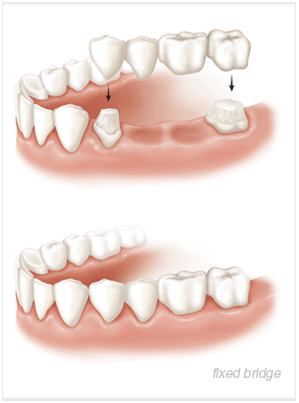Replacing Multiple Teeth

Replacing multiple teeth can be achieved with a multiple single-tooth implant restoration, with implant fixed partial dentures (implant bridges), with a removable partial denture (RPD), or with a conventional fixed partial denture (FPD).
 The missing teeth may be replaced with multiple single-tooth implant restorations (described under replacing single teeth), or with implant fixed partial dentures (implant bridges).Implant bridges replace the support lost as a result of missing teeth, avoid the need to drill the adjacent teeth and do not require an implant for every missing tooth. The space, gum tissue and underlying bone must be appropriate to place the dental implants.
The missing teeth may be replaced with multiple single-tooth implant restorations (described under replacing single teeth), or with implant fixed partial dentures (implant bridges).Implant bridges replace the support lost as a result of missing teeth, avoid the need to drill the adjacent teeth and do not require an implant for every missing tooth. The space, gum tissue and underlying bone must be appropriate to place the dental implants.
Implants are placed in strategic positions to replace the missing teeth. When the implants are stable and ready for loading, abutments can be attached to the implants that will connect the final bridge (prosthesis) to the implants. An impression is made recording the contours of the abutments or the position of the implant tops. The implant bridge is then fabricated and retained in place using cement or screws.
An implant bridge is not susceptible to cavities but may develop complications if oral hygiene is not maintained. This implant restoration should be routinely evaluated – the time interval dependent upon the conditions of the remaining natural teeth and the implant bridge. Restorations using porcelain may be susceptible to a low incidence of porcelain fracture. Patients with large functional forces, including bruxism, may require stronger metal chewing surfaces.
Implant-assisted removable partial dentures (IRPD) utilize a few select implants placed in strategic positions and connected to the overlying denture by means of some sort of stud screwed into the implant. These key implants may eliminate unsightly clasps, reduce the display of metal parts on the RPD, and will increase the amount of support, stability and retention to the final restoration.
With an appropriate design, an IRPD may be modified to add any teeth that may require removal in the future. When the implants are stable and ready for loading, abutments can be attached to the implants. The abutments may be used individually as stud attachments or as part of a larger, laboratory manufactured super-structure with various types of clip-type attachments (or retentive elements) which engage the RPD. An impression of the teeth and retentive elements is made so the laboratory can fabricate the final prosthesis. The retentive elements may be processed in the laboratory or in a clinical procedure that is performed chair-side. This implant restoration should be routinely evaluated at time intervals that are dependent upon the conditions of the remaining natural teeth and the implant RPD. The denture teeth and retentive elements will be subject to wear and will need to be replaced when necessary. Denture teeth will generally last for years but most retentive elements need to be replaced on a six-month or longer basis.
Replacement with a conventional removable partial denture (RPD) is indicated for patients who can accept having a restoration that is NOT permanently fastened. This restoration should be removed on a daily basis by the patient for oral hygiene access to the remaining natural teeth and the prosthesis. The RPD is made up of a metal framework, denture teeth and acrylic. Some patients may not like the appearance of the clasps (metal arms) that engage the remaining teeth to retain the prosthesis, the display of portions of the metal framework, the denture teeth and acrylic. Replacement of worn denture teeth, as well as relining the prosthesis to maintain proper adaptation to the gums, is usually necessary over time.
The major advantages of an RPD are minimal preparations of the adjacent teeth (significantly less than a bridge), replacement of missing teeth, cosmetic replacement of the lost volume of gum and bone, reduced expense and easier access for oral hygiene. With an appropriate design, an RPD may be modified to add any teeth that may require removal in the future.
Replacement with a conventional fixed partial denture (FPD) or bridge requires reduction of two or more adjacent teeth to make crowns that will be connected to each other with a false (prosthetic) tooth suspended between them. A fixed bridge increases the functional forces placed upon the supporting teeth and complicates the use of floss between the teeth. The number of natural teeth that require reduction is dependent upon many factors which include the number and span of the missing teeth, the location in the jaw, and the condition of the involved teeth themselves. Conventional bridges may need to be replaced if the supporting teeth develop cavities or periodontal disease.




